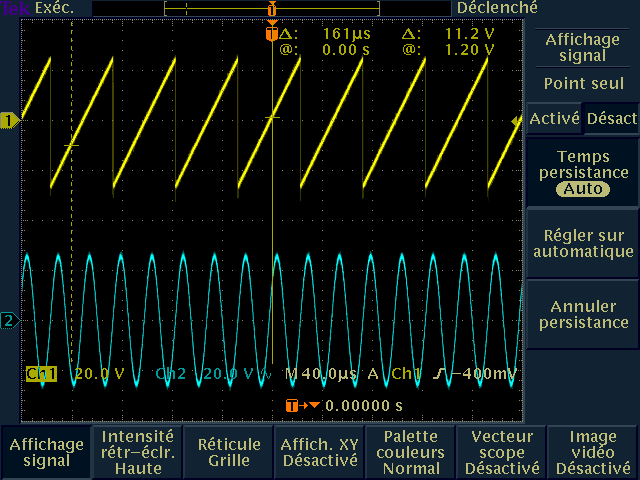Before going to the serial port subject, I took some time to analyze the display pins.
The clocks were easy and matched what I found about some simple color LCD datasheets
- DotClock : pin 2 (25MHz, 50% duty cycle)
- HSync : pin 3 (31.5KHz, 88% duty cycle, 31.72µs high and 3.82µs low)
- VSync : pin 4 (60Hz, 99.6% duty cycle)
The colors bus needed more work to distinguish the good colors and what pin were what color bit as it was impossible to see them on the photos of the board.
I had to play with the color schemes and the signal intensity to see emerging patterns to find the bits of each colors :
- Red[0-3] : pins 6 to 9
- Green[0-3] : pins 51, 52, 54 and 55
- Blue[0-3] : pins 56, 57, 59 and 60
That done !
Now back to the serial port.
Yes, it's bugged me.
I came to the conclusion that i needed to force the scope to detect a "virtual legit card" with a serial port and a GPIB.
After some more time contemplating the board photos, it made sense that the TTLs had a role to play with that but no way to confirm it without a schematics of the board. It was at that time I sawn a wall. The photos where not clear enough to extract correctly the traces.
But came another EEVBlog member who gave me an important information : enabling the TDS3ENG application module activate the serial port !
Some more I2C programming, and i had the serial port activated !!!!
But ... it didn't respond to any GPIB commands !!!!
Bah at least I can now use the serial port to print the screen to my PC with a little quick and dirty python script.
from serial import Serial
from time import sleep
from time import time
s = Serial(port="/dev/ttyUSB4", baudrate=38400)
wait = -1
with open("dump.png", "wb") as f:
while True:
data = s.read_all()
print("%s : Received %u ... " % (time(), len(data)))
if len(data):
f.write(data)
wait = 3
elif wait >= 1:
wait -= 1
if wait == 0:
exit()
sleep(1)
many seconds later ... it's slow even at 38.4KBps

Even if i still need to find a way to simulate the presence of a card, i can now slowly print a screen capture to the serial port if needed.
 PMercier
PMercier
Discussions
Become a Hackaday.io Member
Create an account to leave a comment. Already have an account? Log In.